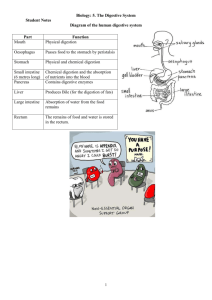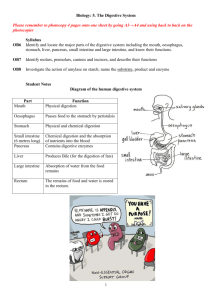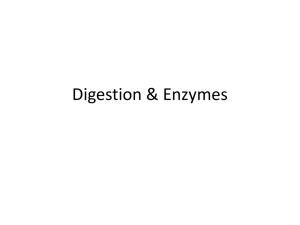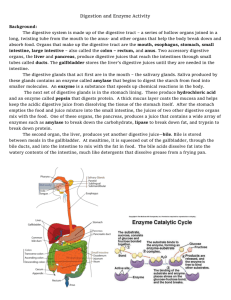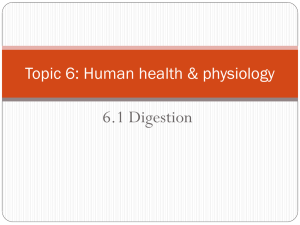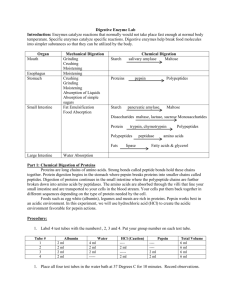5. The Digestive System
advertisement
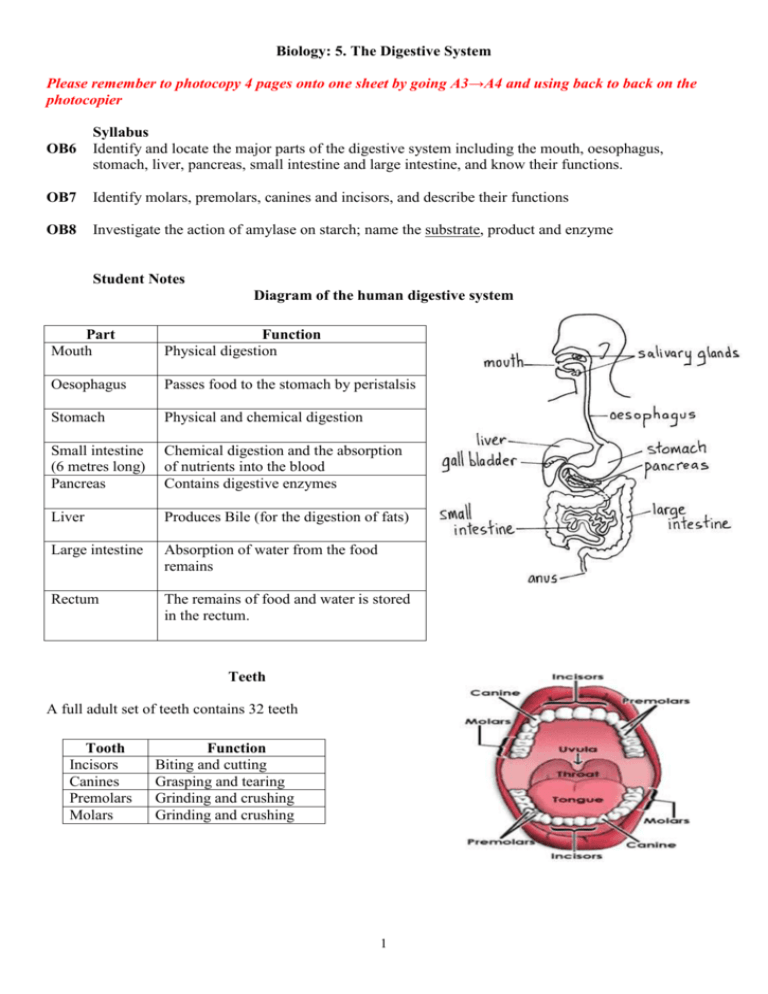
Biology: 5. The Digestive System Please remember to photocopy 4 pages onto one sheet by going A3→A4 and using back to back on the photocopier OB6 Syllabus Identify and locate the major parts of the digestive system including the mouth, oesophagus, stomach, liver, pancreas, small intestine and large intestine, and know their functions. OB7 Identify molars, premolars, canines and incisors, and describe their functions OB8 Investigate the action of amylase on starch; name the substrate, product and enzyme Student Notes Diagram of the human digestive system Part Mouth Function Physical digestion Oesophagus Passes food to the stomach by peristalsis Stomach Physical and chemical digestion Small intestine (6 metres long) Pancreas Chemical digestion and the absorption of nutrients into the blood Contains digestive enzymes Liver Produces Bile (for the digestion of fats) Large intestine Absorption of water from the food remains Rectum The remains of food and water is stored in the rectum. Teeth A full adult set of teeth contains 32 teeth Tooth Incisors Canines Premolars Molars Function Biting and cutting Grasping and tearing Grinding and crushing Grinding and crushing 1 Enzymes A catalyst is a chemical that speeds up a chemical reaction. An enzyme is a biological catalyst. The substance an enzyme acts on is the substrate and the substance formed by the reaction is the product. Amylase is an example of an enzyme and is used to break down starch into a reducing sugar called maltose. Therefore in this case starch is the substrate and sugar is the product. Amylase is found in saliva. To demonstrate the action of salivary amylase on starch 1. Add some saliva (which contains the amylase enzyme) to a starch solution which is in a test tube. 2. Heat in a water bath at 37 0C for 10 minutes. 3. The starch should now be converted to a simple sugar called maltose so we need to test for this. Add some Benedict’s solution and place in boiling water for a few minutes. 4. The contents of the test-tube should turn red, indicating that sugar is present. Fun Activities – ask your teacher to let you try these in class! 1. How many crackers can you eat in one minute without drinking water? You’ll be surprised how few you can eat. Can you think why? 2. Get two people to hold you upside down. Now try to drink water out of a glass using a straw. Can you still drink the water, and if so have you any idea how you can defy gravity? 2 Exam Questions Identification and function of parts 1. [2011 OL] [2010 OL] [2007 OL] [2006 OL] Digestion of food is important so that we can obtain energy from our food. Name the parts of the digestive system labelled A, B and C in the diagram. 2. [2010] [2010 OL] [2007 OL] [2006 OL] Give one function of the stomach. 3. [2007] Give a digestive function of the liver. 4. [2007] Give a function of the small intestine other than digestion. 5. [2010][2007 OL] Give one function of the large intestine. 6. [2010] The diagram of the human digestive system has been simplified for clarity. (i) What is digestion? (ii) Why is digestion necessary? (iii)Name the organs labelled A and B. Teeth 7. [2006 OL] Name the mineral needed for healthy growth of teeth. 8. [2011 OL][2009 OL][2006 OL] A tooth is labelled T in the diagram. (i) What is the name of the type of tooth labelled T? (ii) What is the function of this type of tooth? 9. [2011] [2007 OL] Two teeth are labelled T in the diagram. (i) What is the name of the tooth labelled T? (ii) What is the function of that type of tooth? 3 Enzymes 10. [2006 OL] Salivary amylase found in the mouth acts on starch in the food we eat. This action can be investigated in the laboratory. Name the chemical used to test for the presence of starch at the beginning of the experiment. 11. [2010 OL] Complete the following sentence: During digestion ___________ acts on starch found in our food and breaks it down to form ________. 12. [2006 OL] When salivary amylase is added to starch solution and the mixture placed in a water bath at 37 °C for 5 minutes, a new product is formed. Name the product formed. 13. [2006 OL] [2008 OL] A chemical is used to test for the presence of maltose. This chemical reacts with maltose to produce a brick-red colour when they are heated together in a hot water bath for 5 minutes. Name this chemical. 14. [2007] In the small intestine starch is broken down to maltose by amylase. Identify the enzyme, and the substrate named in this reaction. 15. [2008 OL] Name a reducing sugar. 16. [2008 OL] (i) What is the colour of the test solution used at the beginning of the experiment To demonstrate the action of salivary amylase on starch? (ii) What is the colour of the test solution that indicates a positive result for the presence of a reducing sugar? 17. [2008] A pupil performed an experiment in a school laboratory to show the action of a digestive enzyme on a food substance. (i) Name an enzyme suitable for such an experiment. (ii) Name a food substance on which the enzyme that you have named will act. (iii) Describe any preparation of the food required before the experiment is performed. (iv) If no preparation is required state why. (v) Give the temperature at which the enzyme-food mix should be maintained for the experiment to work. (vi) How much time is needed for digestion of the food in this experiment? (vii) Describe a test to confirm that digestion has occurred. 18. Without enzymes we would not be able to exist. Enzymes release energy from food, help build the molecules that our bodies are composed of and break down structures and wastes that we no anger needed (i) Name an enzyme. (ii) Name the substrate that the enzyme you have named acts on. (iii)Name the product of the action of this enzyme. (iv) What reagent might you use, in a laboratory, to test that the reaction has taken place? 19. [2007] Describe a simple laboratory experiment to show the release of chemical energy from food as heat. 4 Exam solutions A = Oesophagus, B = Stomach, C = Large intestine Digest food / breakdown food / to mix food / produce acid / produce enzymes / kill bacteria / holds food It produces bile / helps digest (breakdown) fats Absorption/ food (nutrients) pass into the blood. Absorbs water / forms faeces (waste) / egestion. 1. 2. 3. 4. 5. 6. (i) Digestion is the breakdown of food (ii) To make food soluble so it can enter the bloodstream. (iii)A is the liver, B is the pancreas. 7. Calcium 8. (i) Incisor (ii) Biting 9. (i) Molar (ii) Chewing 10. Iodine 11. 1. Amylase 2. Maltose 12. Maltose 13. Benedict’s solution / Fehling’s reagent 14. Enzyme: Amylase Substrate: Starch 15. Glucose 16. Blue Brick red 17. (i) Amylase (ii) Starch (iii) Mix the starch with water/ produce saliva (iv) 37 degrees Celsius/ body temperature (v) 10 minutes (vi) Add iodine; the mixture does not turn blue-black. or Add Fehling’s solution/ Benedict’s solution: the mixture turns red/ orange/ brown 18. (i) Amylase (ii) Starch (iii)Maltose (iv) Iodine solution/ Benedict’s solution/ Fehling’s solution 19. Burn a peanut (crisp) (cracker) under a container of water. The temperature of water rises. 5 Class Questions 1. Copy the table, list the four types of teeth and give the function of each using the table provided: Type of tooth Function 1 2 3 4 2. Give the function of each of the following in the table provided: Body Part A Mouth B Oesophagus C Stomach D Liver E Pancreas F Small intestine G Large intestine Function 3. (i) Identify each of the parts of the digestive system in the diagram by putting the appropriate letter from Question 2 beside each part. (ii) Mark on the diagram where digestion, absorption and egestion occur. 6 The Digestive System Crossword Across 4. Teeth used for grinding and crushing. (6) 5. Teeth used for grasping and tearing. (7) 8. If sugar is present then the solution will turn this colour when tested correctly. (3) 9. A biological catalyst. (6) 10. Chemical used to test for starch. (6) 12. Where physical digestion takes place. (5) 13. It produces bile (for the digestion of fats). (5) 15. This is an enzyme used to break down starch. (7) 17. Teeth used for biting and cutting. (8) 19. Chemical solution used to test for sugar. (9) 20. Physical and chemical digestion take place here. (7) Down 1. It contains digestive enzymes. (8) 2. Chemical digestion and the absorption of nutrients into the blood occur here (5, 9). (14) 3. This is where absorption of remaining water from the food takes place (5, 9). (14) 6. This is where food gets passed to the stomach by peristalsis. (10) 7. The remains of food and water is stored here. (6) 11. A chemical used to speed up a chemical reaction. (8) 14. If starch is present then the solution will turn this colour when tested correctly. (5) 16. The substance an enzyme acts on. (9) 18. A everyday source of amylase. (6) 7 The Digestive System – Wordsearch AMYLASE CANINES INCISORS MOLARS PANCREAS SALIVA SUBSTRATE BENIDICTS CATALYST IODINE MOUTH RECTUM SMALLINTESTINE BLACK ENZYME LARGEINTESTINE OESOPHAGUS RED STOMACH 8

